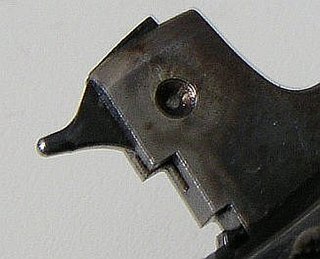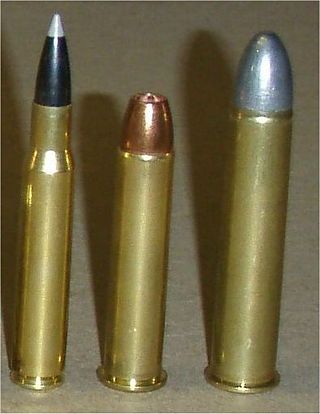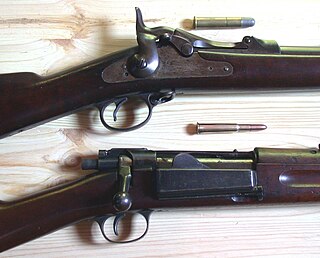Related Research Articles

In firearm designs, the term single-shot refers to guns that can hold only a single round of ammunition inside and thus must be reloaded manually after every shot. Compared to multi-shot repeating firearms ("repeaters"), single-shot designs have no moving parts other than the trigger, hammer/firing pin or frizzen, and therefore do not need a sizable receiver behind the barrel to accommodate a moving action, making them far less complex and more robust than revolvers or magazine/belt-fed firearms, but also with much slower rates of fire.

The M1903 Springfield, officially the United States Rifle, Caliber .30-06, Model 1903, is an American five-round magazine-fed, bolt-action service repeating rifle, used primarily during the first half of the 20th century.
The term Springfield rifle may refer to any one of several types of small arms produced by the Springfield Armory in Springfield, Massachusetts, for the United States armed forces.

A firing pin or striker is a part of the firing mechanism of a firearm that impacts the primer in the base of a cartridge and causes it to fire. In firearms terminology, a striker is a particular type of firing pin where a compressed spring acts directly on the firing pin to provide the impact force rather than it being struck by a hammer.

The lock of a firearm is the mechanism used to initiate firing. It is a historical term, in that it generally refers to such mechanisms used in muzzle-loading and early breech-loading firearms. Side-lock refers to the type of construction, in which the individual components of the mechanism are mounted either side of a single plate. The assembly is then mounted to the stock on the side of the firearm. In modern firearm designs, the mechanism to initiate firing is generally constructed within the frame or receiver of the firearm and is referred to as the firing or trigger mechanism.

The .45-70, also known as the .45-70 Government, .45-70 Springfield, and .45-21⁄10" Sharps, is a .45 caliber rifle cartridge originally holding 70 grains of black powder that was developed at the U.S. Army's Springfield Armory for use in the Springfield Model 1873. It was a replacement for the stop-gap .50-70 Government cartridge, which had been adopted in 1866, one year after the end of the American Civil War, and is known by collectors as the "Trapdoor Springfield".
The Springfield Model 1873 was the first standard-issue breech-loading rifle adopted by the United States Army. The rifle, in both full-length and carbine versions, was widely used in subsequent battles against Native Americans.

The Springfield Model 1865 was an early breech-loading rifle manufactured by U.S. Armory in Springfield, Massachusetts. It was a modification of the Springfield Model 1861. It was later replaced with the Springfield Model 1866.

The Springfield Model 1866 was the second iteration of the Allin-designed trapdoor breech-loading mechanism. Originally developed as a means of converting rifle muskets to breechloaders, the Allin modification ultimately became the basis for the definitive Springfield Model 1873, the first breech-loading rifle adopted by the United States War Department for manufacture and widespread issue to U.S. troops.

The Springfield Model 1870 was one of the rifles which used the trapdoor breechblock design developed by Erskine S. Allin. The Model 1870 was a minor improvement to the Springfield Model 1868, and retained most of the Model 1868 rifle features.

The Springfield Model 1868 was one of the rifles which used the trapdoor breechblock design developed by Erskine S. Allin.

The Springfield Model 1892–99 Krag–Jørgensen rifle is a Norwegian-designed bolt-action rifle that was adopted in 1892 as the standard United States Army military longarm, chambered for U.S. caliber .30-40 Krag cartridges. All versions and variants were manufactured under license by the Springfield Armory between 1892 and 1903 and famously served as the longarm during the Spanish–American War.
The Remington Model 30 is a US sporting rifle of the inter-war period based on the military P14/M1917 Enfield rifle action, which was manufactured for the British and US governments during World War I. Initial specimens used surplus military parts with some modifications in order to consume the stock of parts, though further modifications were made as production progressed and later rifles were produced from newly manufactured parts. Most early rifles were in the military .30-06 calibre used in the M1917 but it became available in a variety of chamberings. It was the first high-powered bolt-action sporting rifle produced by Remington. Some would beg to differ as Remington made the Remington Lee factory sporting rifle from 1899-1909, 1446 were built in a variety of calibers.
The CZ-550 is a bolt-action hunting rifle series manufactured by Česká zbrojovka Uherský Brod. The CZ 550 series is available with a medium or magnum sized action. The CZ 550 rifle is based on the Mauser 98 rifle.
The Winchester Hotchkiss was a bolt-action repeating rifle patented by Benjamin B. Hotchkiss in 1876 and produced by the Winchester Repeating Arms Company and Springfield Armory from 1878. The Hotchkiss, like most early bolt-actions, had a single rear locking lug integral with the bolt handle, but was unique in feeding multiple rounds from a tubular buttstock magazine similar to the Spencer rifle. The .45-70 Hotchkiss was acquired in limited numbers by the US Navy as the M1879, and by the US Army and several state militias as the M1883, making it the first center-fire bolt-action repeater to be adopted by any major military.
The Springfield Model 1869 was one of several model "trapdoor Springfields", which used the trapdoor breechblock design developed by Erskine S. Allin.
The Springfield Model 1882 Short Rifle was a trapdoor rifle based on the design of the Springfield Model 1873. It is usually referred to as a "short rifle" but is sometimes called a "carbine".
The Springfield model 1884 was one of the "Trapdoor Springfield" rifles. It was an improved replacement for the previous longarm of the U.S. Armed Forces, the Springfield model 1873.
The Springfield Model 1886 was one of several models of carbines which used the trapdoor breechblock design developed by Erskine S. Allin. It was Springfield Armory's second attempt to create a single longarm that would satisfy the needs of the infantry, cavalry, and artillery.

In firearms, a trapdoor is a form of breech-loading mechanism for rifles in which a hinged breechblock rotates up and forward, resembling the movement of a trapdoor. The Springfield models 1865 and 1873 were best known for first employing this type of action.
References
- ↑ "Model 1875 Officer's Rifle". The U.S. Springfield Trapdoor Information Center. Retrieved 2021-08-21.
- 1 2 "Rifles and ammunition and rifle shooting" By Harcourt Ommundsen, Ernest Herbert Robinson